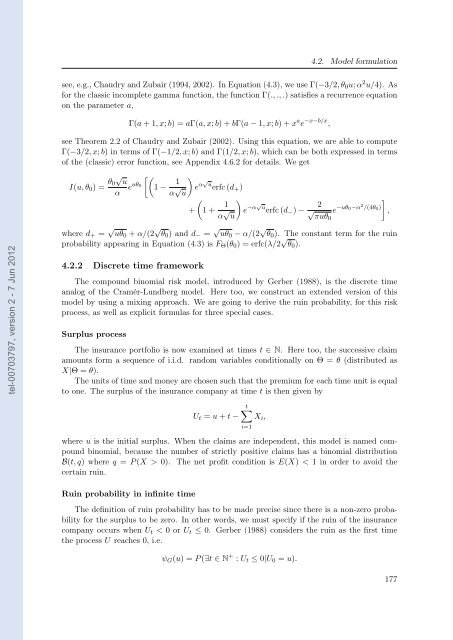Etude des marchés d'assurance non-vie à l'aide d'équilibres de ...
Etude des marchés d'assurance non-vie à l'aide d'équilibres de ...
Etude des marchés d'assurance non-vie à l'aide d'équilibres de ...
Create successful ePaper yourself
Turn your PDF publications into a flip-book with our unique Google optimized e-Paper software.
tel-00703797, version 2 - 7 Jun 2012<br />
4.2. Mo<strong>de</strong>l formulation<br />
see, e.g., Chaudry and Zubair (1994, 2002). In Equation (4.3), we use Γ(−3/2, θ0u; α 2 u/4). As<br />
for the classic incomplete gamma function, the function Γ(., ., .) satisfies a recurrence equation<br />
on the parameter a,<br />
Γ(a + 1, x; b) = aΓ(a, x; b) + bΓ(a − 1, x; b) + x a e −x−b/x ,<br />
see Theorem 2.2 of Chaudry and Zubair (2002). Using this equation, we are able to compute<br />
Γ(−3/2, x; b) in terms of Γ(−1/2, x; b) and Γ(1/2, x; b), which can be both expressed in terms<br />
of the (classic) error function, see Appendix 4.6.2 for <strong>de</strong>tails. We get<br />
I(u, θ0) = θ0<br />
√<br />
u<br />
α euθ0<br />
<br />
1 − 1<br />
α √ <br />
u<br />
+<br />
e α√ u erfc (d+)<br />
<br />
1 + 1<br />
α √ u<br />
<br />
e −α√ u erfc (d−) −<br />
2<br />
√ e<br />
πuθ0<br />
−uθ0−α2 <br />
/(4θ0)<br />
,<br />
where d+ = √ uθ0 + α/(2 √ θ0) and d− = √ uθ0 − α/(2 √ θ0). The constant term for the ruin<br />
probability appearing in Equation (4.3) is FΘ(θ0) = erfc(λ/2 √ θ0).<br />
4.2.2 Discrete time framework<br />
The compound binomial risk mo<strong>de</strong>l, introduced by Gerber (1988), is the discrete time<br />
analog of the Cramér-Lundberg mo<strong>de</strong>l. Here too, we construct an exten<strong>de</strong>d version of this<br />
mo<strong>de</strong>l by using a mixing approach. We are going to <strong>de</strong>rive the ruin probability, for this risk<br />
process, as well as explicit formulas for three special cases.<br />
Surplus process<br />
The insurance portfolio is now examined at times t ∈ N. Here too, the successive claim<br />
amounts form a sequence of i.i.d. random variables conditionally on Θ = θ (distributed as<br />
X|Θ = θ).<br />
The units of time and money are chosen such that the premium for each time unit is equal<br />
to one. The surplus of the insurance company at time t is then given by<br />
Ut = u + t −<br />
t<br />
Xi,<br />
where u is the initial surplus. When the claims are in<strong>de</strong>pen<strong>de</strong>nt, this mo<strong>de</strong>l is named compound<br />
binomial, because the number of strictly positive claims has a binomial distribution<br />
B(t, q) where q = P (X > 0). The net profit condition is E(X) < 1 in or<strong>de</strong>r to avoid the<br />
certain ruin.<br />
Ruin probability in infinite time<br />
The <strong>de</strong>finition of ruin probability has to be ma<strong>de</strong> precise since there is a <strong>non</strong>-zero probability<br />
for the surplus to be zero. In other words, we must specify if the ruin of the insurance<br />
company occurs when Ut < 0 or Ut ≤ 0. Gerber (1988) consi<strong>de</strong>rs the ruin as the first time<br />
the process U reaches 0, i.e.<br />
i=1<br />
ψG(u) = P (∃t ∈ N + : Ut ≤ 0|U0 = u).<br />
177
















